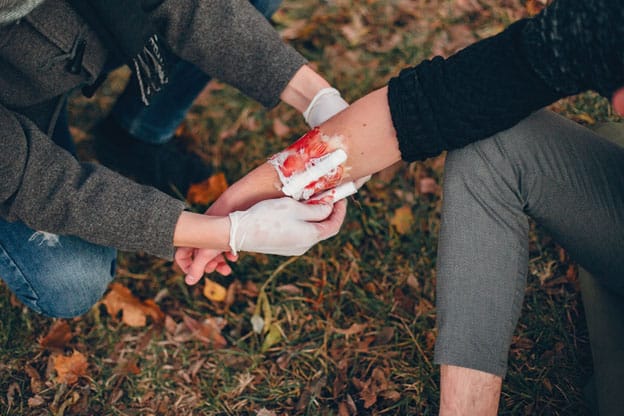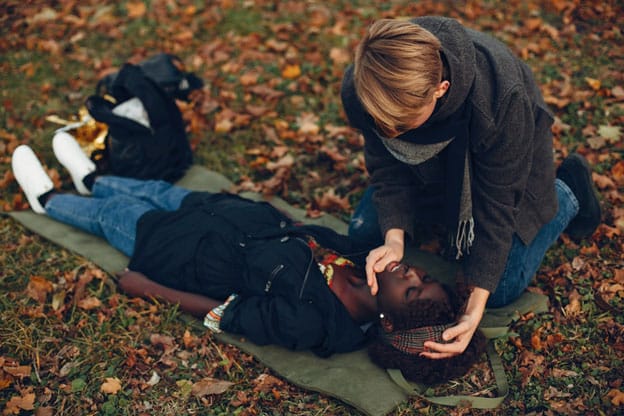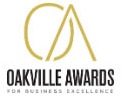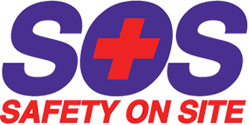With the wonderful summer months over, students have gone back to school. Some have walked through the doors of High School for the very first time. It can be a scary and exciting time, learning new things, meeting new people. This is where students start to enter adulthood. They are creating their own unique identity. They start enjoying new activities, sports, going out with friends and being without parental supervision.
But with all this newfound freedom come risky behaviours, and it’s important for High school students to be equipped with life skills to handle new situations that they might encounter.
This is where learning some basic life-saving skills during a Red Cross First Aid and CPR Course can come in very important!
Let’s picture the first high school party, with lots of people, and everyone socializing and having a good time! There are many distractions like drinking and drugs. Imagine, suddenly, someone trips down the front steps and hits their head leading to a head injury; or imagine someone eating a cupcake with peanuts causing a severe allergic reaction; or imagine a substance poisoning situation where a person goes unresponsiveness and stops breathing. What does a young bystander do? Can they help, can they be prepared? Absolutely!

1) Emergencies Can Happen Anytime & Anywhere
Unfortunately, accidents don’t adhere to any time schedule or have set locations. A medical emergency can happen at school, on the football field, at home, or in any other public or private space. It is critical that our young adults know how to respond effectively in these stressful and potentially life-threatening situations. Knowing how to perform first aid and CPR can give students confidence and make the difference between life and death.
2) Prevention
Learning First aid empowers students with not only the confidence and skills to react and assist in an emergency, but also the knowledge of how to prevent a first aid incident from occurring. First Aid courses cover how to deal with an emergency, and what can cause that incident in the first place.
With the young adult’s brain still developing, studies have shown that they are more likely to engage in risky behaviour.
These risky behaviours can result in numerous types of emergencies. These emergencies can include:
- Head and spine injuries
- Strains and sprains
- Fractures
- Heat related emergencies
- Asthma attacks
- Seizures
- Bruises
- Burns
- Allergic reactions
- Seizures
- Fainting
- Dehydration
- Alcohol poisoning
- Opioid poisoning
If we empower students with the ability to take control in emergencies and understand them, this might help our students think first before engaging in risky or dangerous situations. This also can influence students to become responsible young adults who not only care about themselves, but also look out for the well-being of others in their community.
3) Creating a Faster Response Time and a Better Outcome
When an emergency occurs seconds can make the difference between a negative or positive outcome. High school students who are trained in first aid can respond more quickly to incidents, whether it’s a peer who has a severe allergic reaction, a slip and fall where someone hit their head, or an incident of opioid poisoning. Rapid response can significantly improve the outcome and reduce the severity of injuries or illnesses.

4) Valuable Addition to Summer Jobs and University/College Applications
Every workplace in Ontario requires first aid trained staff. Employers are more likely to hire students who are first aid certified for summer or year-round employment. Lifeguards, swim instructors, camp councillors, daycare providers, babysitters, etc.) – there are so many jobs that require candidates and staff to be trained in first aid.
5) Careers or applications that require Standard First Aid & AED Certifications or CPR BLS Certifications
Nearing the end of High School, it will be time for students to start their post-secondary applications or enter the workforce. For students planning on pursuing a career in any of the emergency first responder fields, Standard First Aid with BLS is a requirement. For students planning on working with children or seniors, Standard First Aid with CPR C is often a requirement. These are just a few of the professions require a valid first aid certification as a prerequisite:
- Nurses
- PSWs
- First responders
- Police
- Paramedics
- Firefighter recruitment
- Pre-service Fire Fighter training
- Lifeguards
- Early childhood education
- Daycare providers
- Fitness instructors
- Trade works
- Plumbers
- Electricians
- Masons
- Mechanics
- Crane operators
- Heavy equipment operators
- Construction workers
- Sports coaches
- Flight attendants
- Hospitality worker
- Teachers
- Security personnel
- Sports and recreation
- Adventure instructors
- Chiropractors
- Physiotherapists and Occupational Therapists
- Dentists, Hygienists, dental assistants

In conclusion, high school students need to learn first aid! They need to be equipped with the knowledge and confidence to respond effectively in emergencies. These valuable, life-saving skills will prepare our students to better face the challenges of adulthood and daily life.






